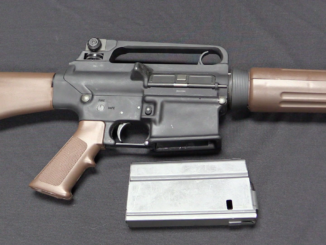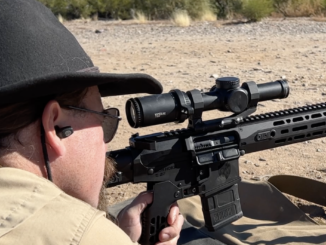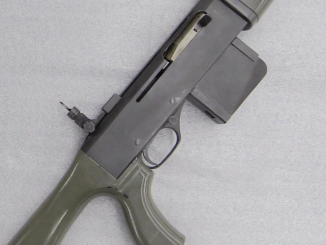This carbine is lot #1416 at Morphy’s April 2019 auction.
The Armstrong & Taylor carbine is a neat single shot breechloading carbine patented in 1862. It operates by way of a button on the top of the rear tang, which allows the barrel assembly to rotate open around a pin located below the barrel. An extractor is mechanically camel to the pin, and pushes the empty cartridge case out as the barrel assembly rotates. The inventors were clearly hoping for a military contract, but were unable to supply the gun to the government until after the Civil War had ended. Instead, it was entered in the 1866 breechloading rifle trials, where it was eliminated (along with 21 other designs) in the first round of trials. It managed to fire 100 rounds of .41 rimfire ammunition at a rate of 14 rounds per minute, but was considered unsuitable. The trials would eventually choose the Allin Conversion as their winner, better known as the Trapdoor Springfield.




Rotating the entire barrel assembly to open the thing? Why does this sound like a bad idea in brutal field conditions?
Auto-incorrect struck again. Camels aren’t included on our list of necessary gun parts…
The Greene carbine had a similar setup;
https://www.youtube.com/watch?v=CdfJZOVkCO4
It was patented in 1855.
Most “patent” breechloading concepts back then showed up in multiple variations at or near the same time. Consider the various breech systems with breechblocks that swung their front ends up, sideways or down, much like the Hall.
The Armstrong & Taylor was doomed from the start, according to an old DBI Books reprint Bannerman catalog I have that lists and illustrates the weapons tested in the 1866 trials. The only systems that were seriously considered were ones that (a) used metallic cartridges and (b) could be used to inexpensively convert the Model 1858, 1861, and Special Model 1862 .58 rifle muskets to breechloading. Which is how we ended up with the “Trapdoor” Springfield.
The Armstrong & Taylor would not have been an inexpensive conversion of a Springfield.
cheers
eon
Seems like it would have been a neat action for a single shot shotgun centerfire or pinfire
I think it would make for a neat slim hunting rifle as well. Certainly more elegant than the Remington Rolling block.
“.41 rimfire ammunition”
Is any ballistic data available? Bullet mass, muzzle velocity, powder charge?
Large calibre rim fire for a military rifle was a technological dead end.
Cases had to be either pure copper or else nickel or copper plated, because any mercury fulminate used to sensitise the priming composition, would react with zinc or iron.
Because the firing pin had to indent the rim, the metal in the rim couldn’t be too thick. chamber pressure was therefore limited by the relatively low strength of the thin copper rim.
This was less of a problem with small diameter case heads, than with larger diameter case heads.
Since the 1920s and 30s, With the invention of styphnate and other compounds that are both non corrosive and don’t react with zinc or iron, higher tensile strength brass and potentially even steel rim fires cases can be used, and higher chamber pressures have become possible in small diameter rim fire cases.
I followed the link to the catalogue for the first time since Julia became Morphy. It’s not a straight link, as I am sure it used to be. I found their site a bit of a bind to navigate; and never did find this gun: but the actual catalogue is a thing of temperamental beauty. It looks like a book, with pages as slow to turn, but the pictures and text are first close. Next time I’m bed ridden it’ll be go to reading.
Apart from anything else I learned about Pennsylvanian gunsmith Melchior Fordney; who was murdered by John Haggerty with a tomahawk because he was refused the loan of a rifle to shot his horse with! https://www.pookandpook.com/melchoir-fordney-the-story-of-a-pennsylvania-master-gunsmith-and-one-of-americas-first-insanity-pleas/
The link took me straight to lot 1416, armstrong & Taylor carbine.